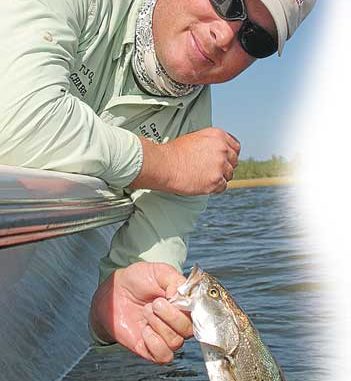
Anglers must pay attention to water levels at the southeast coast or pay the piper when it comes to finding specks.
It was late on a balmy October morning when Steve Laughinghouse returned to his community marina along the ICW near Carolina Beach.
His neighbors came to admire his catch as he began to unload trout the size of fireplace logs at the fish-cleaning station. He laughed and joked and told them he caught them along the bank.
“I don’t mind telling people where I catch speckled trout because there’s a lot more to it than knowing where to go,” Laughinghouse said. “It’s more important knowing when to go.”
Unlike many areas where fabled trout fishing is in store for those who venture forth in the fall, the Cape Fear area presents unique problems. At places such as New River, Swansboro and Pamlico Sound, anglers venture far into the backwaters and headwaters without having to worry about the affects of rising and falling tides. But at the southern coast, the tide swing is severe.
“The timing of the bite is so interdependent on the timing of the tide that knowing the tide table for the places you fish is more important than anything else,” he said. “It’s more important than weather, bait, wind or time of day.”
Laughinghouse prefers falling tide stages for most of his speckled trout fishing. The falling tide, he said, concentrates baitfish, which in turn concentrates predators such as speckled trout. He has boated so many limits of keeper trout he can’t keep track of them. He also has dozens of awards from the NCDMF Saltwater Tournament, which anglers refer to as “citations,” as proof of his speck-seeking prowess.
“All the flats in Masonboro Sound, along the ICW and the Cape Fear River are virtually dry during low tide,” Laughinghouse said. “The fish know when the tide is falling and leave the grass beds and smaller creeks. When they have to leave, they head for deeper water or they’ll get caught high and dry.”
Laughinghouse observes as he travels. He watches for structure that may hold speckled trout. He said the first cue for specks is anything hard or manmade.
“If the water is falling out of a marsh, I watch along the banks for oyster shells and mud ledges,” he said. “Specks stalk those areas as the baitfish swim by.
“If I see lots of bait showering as they pass structure, it’s a good bet they’re jumping to get away from trout.
“Sometimes you see big boils where the trout are rushing up from below. Sometimes trout break the surface. A speck pops the water as it opens its mouth. Sometimes you see the mouth open and make the splash as the trout inhales a baitfish. But a trout doesn’t leap clear of the water like a ladyfish or bluefish.”
Most of Laughinghouse’s fishing is done in water from less than 4-feet deep. While he’s an expert deepwater flounder fisherman, he said specks are easier to catch when they are shallow.
“The deepest water I fish for specks is the along the Masonboro Inlet Jetties,” he said. “There can be some good fishing at the inlet, but if the fish are in, you’ll be fighting a crowd for anchoring space.”
Most jetty anglers buy live shrimp or use scented artificial soft lures. Laughinghouse uses shrimp, but prefers a fresh mullet or menhaden when he can catch them.
“A live shrimp works better when the water is colder and there aren’t as many bait-stealers around,” he said. “Bluefish and pinfish make short work of a dozen shrimp.”
When he fishes with live mullet or menhaden, Laughinghouse uses a float rig or a Carolina rig. For float rigs he uses a clip-on Styrofoam float.
“I cast it into good territory and let it drift along on the falling tide,” he said. “A float rig allows options. Once the fish leave the Masonboro marshes, they head for the edges of the ICW.
“You may be catching them in one of the creeks dumping into the ICW by floating a mullet. Then, as the tide falls and they quit biting, you look around for a dock or a shell bank nearby. With the same float rig, you let your bait drift and catch trout that have moved to the other structure.
“A float rig is perfect for fishing a dock. You anchor up-current and let the float take the bait to the edge of the dock or under it.”
Laughinghouse uses medium action, 7-foot spinning rods with 12- to 15-pound test monofilament lines for specks — the same outfit he uses for flounder.
“I catch pretty big specks, so I use heavier line and tackle to handle them,” he said. “I haven’t experienced a lack of strikes by using the heavier gear than most anglers, and I have seen lighter lines fail when they’ve contacted dock pilings or shells. With the heavier lines, there’s also no need to tie on a leader when you use a lure.”
Laughinghouse mostly uses a scented lure called the Fishbites Xreme Scent Release Lure. He fishes the soft bait in contrasting colors, typically gray on top with a white underbelly and prefers the “Jerk Bait” style. He hooks the lure on a standard, ¼-ounce jig head, ties it on the line and begins casting.
“I buy them by the bucketful,” he said. “They work that well. I’ve found that if he’s there, a fish will usually strike it.”
Still, Laughinghouse experiments from time to time. He tried the newer model MirrOlure, the MR17 and found it worked well.
“The trout were chasing minnows schooling around a creek mouth in the river, and the trout were blowing them up on the surface everywhere,” he said. “Sometimes they would hit the fluke, but it didn’t seem like it was working as well as it should.
“The MR17 (MirrOlure) did the trick. I use it as a twitch-bait, reeling it with a jerking retrieve.
“You may go through four or five lures, catching a few fish on each one from the same place, or you may only get action on one lure. I’ve had the best luck with the scented soft plastic so that’s my go-to lure.”
Many trout fishermen have expensive flats boats that maneuver in super-shallow water. But the 6-foot tide in the Cape Fear area means any shallow draft boat will do well with specks if the angler studies the tides.
“I do fine in a 19-foot Carolina Skiff,” Laughinghouse said. “I don’t have a trolling motor.
“Typically, I spot an area I want to fish and anchor within easy casting distance. Some people use electronics too much.
“If you run over an area while using a depthfinder and a trolling motor, you’ve already spooked the fish. I want to sneak close and drop anchor without making too much noise. When fish are shallow, they’re alert. You don’t want to be rattling the anchor chain on the gunwale.”
In the event he’s spooked some fish while getting into position, Laughinghouse waits a bit before giving up on a spot.
“I give it 30 minutes before moving,” he said. “If the trout were there, they’ll come back as long as the bait is still moving.
“Sometimes I try to get there ahead of the right tide to get a good spot. There aren’t many secret places, so getting there early enough to fish a prime spot before everyone else can spell the difference between success and failure.”
The other main measure of advice for success is simply going fishing and staying out there. Laughinghouse said it’s easy to get discouraged.
“This isn’t an area like some of the bigger sounds, where there could be trophy speck anywhere,” he said. “They can be on fire today and gone tomorrow.
“You can fish lots of good spots before you find them. I may fish six places on one tide. If I catch a limit, that’s a great day. But I may try the same place the next day and catch only one or two.
“Speck fishing is always a gamble and that’s why it will hook you like nothing else. It feels so good when you have a cooler full of specks heading to the dock, it makes up for those days when it’s empty.
Laughinghouse weighs fish he thinks will qualify for a citation at Reel Bait and Tackle. The owner, Trey Summers, who has fished the local waters all of his life said Laughinghouse is one of his top trout anglers. Like Laughinghouse, he fishes the shallows from a flat bottom Carolina Skiff.
“The warm winters we’ve been helping our speck fishing,” Summers said. “We catch them all the way upriver to Wilmington and downriver to Bald Head, although Carolina Beach Inlet is as good a place as any.
“We catch them on the mud banks on the north side of the inlet. Sometimes they’re mixed with gray trout.”
Summers uses a Carolina rig baited with a finger mullet to fish the mud banks on the north side of the inlet. But in the river, he uses a Charleston float rig, which is essentially a Carolina rig with a slip float on the line.
A bobber stop is used to stop the float at a predetermined depth when the bait is in the water. But when the line is reeled in, the float slides down the line to the swivel, making the terminal tackle compact for easier casting.
“We sell live shrimp after October because it’s hard for anglers to catch them that time of year,” Summers said. “A speck isn’t going to turn down a live shrimp if you put it in his face.”
His favorite artificial lure is the Billy Bay Jumping Halo Shrimp by Betts. He said the key to its effectiveness is the eye at the top of the lure.
“The location of the tying eye makes it jump more like a shrimp than the D.O.A. shrimp, which has the eye in front,” he said. “The Billy Bay is a softer than the D.O.A., but the D.O.A. is still a good lure. It’s tried and true.”
These shrimp imitations are pre-weighted, and Summers prefers the ¼-ounce size. He usually fishes them with a float rig, but sometimes fishes them without a float.
“If I’m fishing on the oyster beds, I always use a float to keep from snagging,” he said. “But if I’m fishing ledges and edges, I just cast and retrieve the lure with short twitches.”
Summers uses a variety of MirrOlures. His favorite pattern is the 808, which has black back, gold sides and orange belly. He uses the 19MR and the 17MR.
“The 17MR resembles glass minnows better than the 19MR because it’s thinner,” he said. “I use the lure that most resembles baitfish and matches the color pattern to the water. I use darker lures in darker water and lighter waters in clearer water.
“In the river, the color depends on rain. Lots of rain means the river will be darker. A lot of rain can drop the salinity, but trout can live in very brackish water. Even after a storm you might find them all the way up to Smith Creek.”
Summers likes fishing the last of incoming tide through the first few hours of falling tide because boat access is best with more water. But he moves to the deeper holes during low tide. Specks are there because they have nowhere else to go.
“Another good tactic is fishing the lighted docks along the ICW at night,” he said. “Lights attract lots of bait. Anywhere I find a lighted dock, I cast the Purple Demon and Night Stalker MirrOlures.”
Summers said he was glad the citation size increased from 4 to 5 pounds this year. He said he was happy for anyone to receive an award, but there are just too many specks of more than 4 pounds.
“It wasn’t always this way, but a 4-pound speck is hardly worth mentioning anymore,” he said. “They’re actually common.
“We’re seeing more fish topping 5 pounds than ever.”

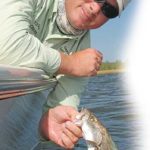

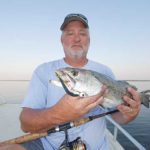
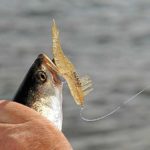
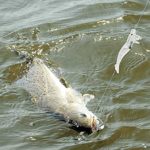
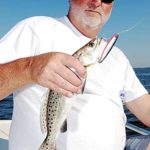




Be the first to comment